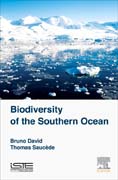
The Southern Ocean surrounding the Antarctic continent is vast, in particular, its history, its isolation, and climate, making it a unique laboratory case for experimental evolution, adaptation and ecology. Its evolutionary history of adaptation provide a wealth of information on the functioning of the biosphere and its potential. The Southern Ocean is the result of a history of nearly 40 million years marked by the opening of the Straits south of Australia and South America and intense cooling. The violence of its weather, its very low temperatures, the formation of huge ice-covered areas, as its isolation makes the Southern Ocean a world apart. This book discusses the consequences for the evolution, ecology and biodiversity of the region, including endemism, slowed metabolism, longevity, gigantism, and its larval stages; features which make this vast ocean a natural laboratory for exploring the ecological adaptive processes, scalable to work in extreme environmental conditions. Today, biodiversity of the Southern Ocean is facing global change, particularly in regional warming and acidification of water bodies. Unable to migrate further south, how will she cope, if any, to visitors from the North? Designed for curious readers to discover the immense ocean surrounding the most isolated and most inhospitable continent on the planet.Describes the Southern Ocean facing biodiversification due to global changeAuthored by scientists with experience of expeditions to the Southern Ocean INDICE: Chapter 1 Introduction Chapter 2. A brief history of exploration and discovery Chapter 3. The Southern Ocean and its environment: a world of extremes Chapter 4. The ocean during the time Chapter 5. Biogeography and communities of the Southern Ocean Chapter 6. History of the biodiversity of the Southern Ocean Chapter 7. Organisms adapation Chapter 8. Projections into the future
- ISBN: 978-1-78548-047-8
- Editorial: Elsevier
- Encuadernacion: Cartoné
- Páginas: 144
- Fecha Publicación: 01/10/2015
- Nº Volúmenes: 1
- Idioma: Inglés
